Happy Christmas Don – Don Cameron gets MBE
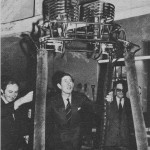 Big ones to Don Cameron who has turned up in the Queen’s New Year Honours List grabbing himself a well-deserved MBE (Member of the Most Excellent Order of the British Empire). The MBE, an order of chivalry established on 4 June 1917 by King George V, has been bestowed on him in recognition for services to Design and Manufacturing under his official title of Dr Donald Allan Cameron, Founder and Managing Director of Cameron Balloons. Dr Don (74) is quoted as saying that the recognition had come as a “complete surprise” and was “very nice indeed”. This isn’t the first time that Don and Cameron Balloons has been feted by Royalty. In 1980 Prince Charles popped round and had a guided tour of the factory, then in St. Matthew’s Church Hall, Cotham, in Bristol and nearly bought basket and burners (end of line special deal) then in 1989 they were awarded the coveted Queen’s Award for Export and a very nice Crystal Chalice to go with it.
Big ones to Don Cameron who has turned up in the Queen’s New Year Honours List grabbing himself a well-deserved MBE (Member of the Most Excellent Order of the British Empire). The MBE, an order of chivalry established on 4 June 1917 by King George V, has been bestowed on him in recognition for services to Design and Manufacturing under his official title of Dr Donald Allan Cameron, Founder and Managing Director of Cameron Balloons. Dr Don (74) is quoted as saying that the recognition had come as a “complete surprise” and was “very nice indeed”. This isn’t the first time that Don and Cameron Balloons has been feted by Royalty. In 1980 Prince Charles popped round and had a guided tour of the factory, then in St. Matthew’s Church Hall, Cotham, in Bristol and nearly bought basket and burners (end of line special deal) then in 1989 they were awarded the coveted Queen’s Award for Export and a very nice Crystal Chalice to go with it.
Congratulations to Don and Co.
Counties Challenge – Go for it in 2014
Need a jolt to get flying on a monthly basis? Want to fill your kitchen with awards? Well you could do worse than enter the Counties Challenge. The objective is to fly furthest in a hot air balloon, taking off and landing within the borders of any chosen County during a given 3 month period, thus winning that counties seasonal challenge. Pilots are encouraged to attempt the seasonal challenge of as many counties as possible. The flight, covering the greatest distance that commences and ends within the borders of any one county during any season, will win the seasonal challenge for that County. At the end of each season the top five Pilots, their distances and points for each county, will be published in The Aerostat and on the Counties Challenge web site. On top of this there is a running score that is totalled up to find the outright winner for the year. The prizes are rather nice as well. An engraved County Salver is awarded to the Pilot who makes the longest flight within each county during the competition year (Pilots may attempt to win more than one County Salver in any year). The Norman Pritchard Counties Challenge Cup is awarded annually to the pilot scoring the highest number of points during the competition year and for the erstwhile crew, each Crew Member of the Challenge Cup winning team will be awarded an embroidered Counties Challenge sweatshirt to commemorate their success. So if the Queen’s Cup got your attention then have a go at the Counties Challenge. The competition is open to all balloonists, is a meagre £7.50 to enter and you can enter at any time. For full details check out the website at http://counties.johnhartley.co.uk/.
Khoas in Melbourne – now that’s a tight landing
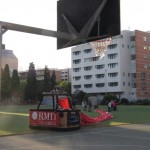 Our old mucker Andy Kaye seems to be thoroughly enjoying himself flying over Melbourne. He reckons he’s never had such a varied bunch of passengers or arrived in stranger of places meeting weird and wonderful people. All sounds a bit luvvie but the flying, he tells us, certainly concentrates the mind as you have to target fly every flight. There is none of this waiting for a field to come under you stuff when flying over a city. If its big enough to deflate the balloon in then it’s a landing site. Trick is to make a decision a bit quick like and fall into the chosen gap in the buildings. He reckons the quick deflation system on the Kavanagh balloon along with its counterweight is absolutely the dog’s. I can see he’ll be saying things like ‘Cripes mate that’s a doddle’, when he gets back and wins the National Championships blindfolded.
Our old mucker Andy Kaye seems to be thoroughly enjoying himself flying over Melbourne. He reckons he’s never had such a varied bunch of passengers or arrived in stranger of places meeting weird and wonderful people. All sounds a bit luvvie but the flying, he tells us, certainly concentrates the mind as you have to target fly every flight. There is none of this waiting for a field to come under you stuff when flying over a city. If its big enough to deflate the balloon in then it’s a landing site. Trick is to make a decision a bit quick like and fall into the chosen gap in the buildings. He reckons the quick deflation system on the Kavanagh balloon along with its counterweight is absolutely the dog’s. I can see he’ll be saying things like ‘Cripes mate that’s a doddle’, when he gets back and wins the National Championships blindfolded.
Aerophile launch Little Prince Park
 Aerophile have announced the launch of the first Aerial Park in the World. Situated in Alsace, the Little Prince Park, manufactured, financed and operated by Aerophile is scheduled to open in the summer of 2014. Set in the beautiful Alsatian landscape and surrounded by the Vosges, the Black Forest, and the Alps it will have within its 23 hectares, 30 attractions, three Movie Theatres with capacities of 60 to 500 seats, two Tethered Balloons, one Aerobar (great), Flying chairs, two giant labyrinths…and plenty of animals it will employ a staff of 50. The attraction is 15 km from Mulhouse train station and 40 km from Balse-Mulhouse airport. With Germany and Switzerland close by and with a potential 10 million inhabitants less than a two hours drive away they are clearly hoping that the Park will become a huge success. The website is already up and running and clearly this huge undertaking is an extremely bold move on the part of Aerophile. We look forward to the opening day celebrations! For more information please visit the website www.leparcdupetitprince.com
Aerophile have announced the launch of the first Aerial Park in the World. Situated in Alsace, the Little Prince Park, manufactured, financed and operated by Aerophile is scheduled to open in the summer of 2014. Set in the beautiful Alsatian landscape and surrounded by the Vosges, the Black Forest, and the Alps it will have within its 23 hectares, 30 attractions, three Movie Theatres with capacities of 60 to 500 seats, two Tethered Balloons, one Aerobar (great), Flying chairs, two giant labyrinths…and plenty of animals it will employ a staff of 50. The attraction is 15 km from Mulhouse train station and 40 km from Balse-Mulhouse airport. With Germany and Switzerland close by and with a potential 10 million inhabitants less than a two hours drive away they are clearly hoping that the Park will become a huge success. The website is already up and running and clearly this huge undertaking is an extremely bold move on the part of Aerophile. We look forward to the opening day celebrations! For more information please visit the website www.leparcdupetitprince.com
Didn’t get a Go-Pro for Christmas? – Try this then
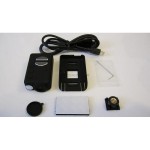 Courtesy of Steve Roake here’s a thing to get you out and about, the Mobius 1080P HD camera system. Steve reckons this represents great value for money and in a world of instant video as it offers the versatility of a Go-Pro style camera at a budget crunching price. This well packaged camera system is simple in its usage, probably lends itself to occasional filmers, comes with all the various mounts you could possibly want, accepts a 32gb memory card and will film for about an hour on 1080 mode. Currently on sale on Amazon for approximately £75, it represents a serious saving on the price of its Go Pro equivalent and, says Steve, seems to be built by people who have listened to what is required in the marketplace. If there is one criticism, Steve reckons there is a lack of waterproofing, but points out that, hopefully, balloonists won’t be using it in the rain. There is a very good video on YouTube comparing like for like at http://youtu.be/YU0Sm4dIOm4 and balanced review at http://youtu.be/7wmIyD1fM4M
Courtesy of Steve Roake here’s a thing to get you out and about, the Mobius 1080P HD camera system. Steve reckons this represents great value for money and in a world of instant video as it offers the versatility of a Go-Pro style camera at a budget crunching price. This well packaged camera system is simple in its usage, probably lends itself to occasional filmers, comes with all the various mounts you could possibly want, accepts a 32gb memory card and will film for about an hour on 1080 mode. Currently on sale on Amazon for approximately £75, it represents a serious saving on the price of its Go Pro equivalent and, says Steve, seems to be built by people who have listened to what is required in the marketplace. If there is one criticism, Steve reckons there is a lack of waterproofing, but points out that, hopefully, balloonists won’t be using it in the rain. There is a very good video on YouTube comparing like for like at http://youtu.be/YU0Sm4dIOm4 and balanced review at http://youtu.be/7wmIyD1fM4M
Return of the Black Horse Meets
Sadly the valiant attempt to hold another Black Horse Mince Meet on News Years’ Day, organised by Helen & Len Vaughan, fell foul of the weather but not to be thwarted news is out that the Black Horse Easter Meet, which although also blown and rained out last year still attracted a good turnout and jolly fine social on the Saturday evening, is set to go ahead this year. More news later on their super duper new evolving website http://www.blackhorseballoons.co.uk/. While we’re at it congratulations to Len and Helen’s eldest, Candy, who married James on Sunday 29th December.
Thruxton Hurricane nears completion
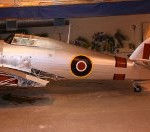 As is always the case with a rebuild as complicated and as thorough as Phillip Lawton’s Hurricane delays and setbacks will occur but the end is now in sight for the Thruxton-based classic. The aircraft is now back in the hangar with the wings off whilst the last of the painting is carried out. The piccie shows her on 24th December with all the painting, bar a few cowlings and the identity code AG 244 which goes in the gap in the red fuselage band, completed. All things being equal and providing the weather plays ball she should be ready to fly in early to mid February. Champagne in the fridge! If you haven’t a clue what we are on about check out the article ‘A brace of Hurricanes – One could be yours’.
As is always the case with a rebuild as complicated and as thorough as Phillip Lawton’s Hurricane delays and setbacks will occur but the end is now in sight for the Thruxton-based classic. The aircraft is now back in the hangar with the wings off whilst the last of the painting is carried out. The piccie shows her on 24th December with all the painting, bar a few cowlings and the identity code AG 244 which goes in the gap in the red fuselage band, completed. All things being equal and providing the weather plays ball she should be ready to fly in early to mid February. Champagne in the fridge! If you haven’t a clue what we are on about check out the article ‘A brace of Hurricanes – One could be yours’.
Santa and Rudolph in space – near tragedy
 Made my December this. Seems that Forest of Dean couple Mark Ireland and girlfriend Cassie Phelps, otherwise known as Stratodean, sent Santa on a Sleigh, pulled by Rudolph, from Coleford to the Edge of Space under a high altitude meteorological balloon. It took two hours for the balloon to climb to just shy of 100,000 feet with its payload which included an onboard camera to film the event. Apparently inspired by a film of a Lego man venturing into space on YouTube they coughed up £50 for the balloon, got a permission from the CAA, filled up with helium and let it go. Careful planning meant that once the balloon went bang a parachute deployed and the camera, Santa and, a somewhat confused, Rudolph were picked up 70 miles away near Yeovil in Somerset after a two and a half hour flight. The video with its hilarious commentary is absolutely brilliant. Visit them at http://www.stratodean.co.uk/. Makes Norad look a tad whimpy. Must try and meet them.
Made my December this. Seems that Forest of Dean couple Mark Ireland and girlfriend Cassie Phelps, otherwise known as Stratodean, sent Santa on a Sleigh, pulled by Rudolph, from Coleford to the Edge of Space under a high altitude meteorological balloon. It took two hours for the balloon to climb to just shy of 100,000 feet with its payload which included an onboard camera to film the event. Apparently inspired by a film of a Lego man venturing into space on YouTube they coughed up £50 for the balloon, got a permission from the CAA, filled up with helium and let it go. Careful planning meant that once the balloon went bang a parachute deployed and the camera, Santa and, a somewhat confused, Rudolph were picked up 70 miles away near Yeovil in Somerset after a two and a half hour flight. The video with its hilarious commentary is absolutely brilliant. Visit them at http://www.stratodean.co.uk/. Makes Norad look a tad whimpy. Must try and meet them.
The amazing Mr Pobjoy – Crash picture turns up
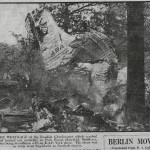 Remember ‘Celia, the Swallow and the remarkable Douglas Pobjoy’? Well there we were enjoying a cuppa when in trotted Dave Jenks and a carrier bag full of stuff his boy had discovered in the school attic. “Have a squint at this”, he said, dumping the zany Budgens bag onto John’s sewing machine. Not a good move. He dragged out an old newspaper and pointed out how well old it was and had some interesting stuff in it. We like interesting stuff especially if its old and crusty. Now I can’t remember what he was interested in or going on about but opening it out there, pretending to listen, suddenly in front of us was a picture of the remains of the DC-6 that was involved in the mid-air collision involving our hero Douglas Pobjoy. It was all a bit strange and not a little disturbing but we read it again and it really was, as if the title of the picture wasn’t enough ‘The wreckage of the Swedish Cloudmaster which crashed and burnt out yesterday in Park Wood, Harefield, Middlesex, after being in collision with an R.A.F. York plane. The plane was en route from Stockholm to Northolt Airport.’ here we were with a copy of the actual news report from July 5th 1948. Then a few days later following a by the by conversation we were sent a copy of ‘Flight’ from the February 3rd 1949 edition containing the‘YORK AND DC-6 COLLISION REPORT’.
Remember ‘Celia, the Swallow and the remarkable Douglas Pobjoy’? Well there we were enjoying a cuppa when in trotted Dave Jenks and a carrier bag full of stuff his boy had discovered in the school attic. “Have a squint at this”, he said, dumping the zany Budgens bag onto John’s sewing machine. Not a good move. He dragged out an old newspaper and pointed out how well old it was and had some interesting stuff in it. We like interesting stuff especially if its old and crusty. Now I can’t remember what he was interested in or going on about but opening it out there, pretending to listen, suddenly in front of us was a picture of the remains of the DC-6 that was involved in the mid-air collision involving our hero Douglas Pobjoy. It was all a bit strange and not a little disturbing but we read it again and it really was, as if the title of the picture wasn’t enough ‘The wreckage of the Swedish Cloudmaster which crashed and burnt out yesterday in Park Wood, Harefield, Middlesex, after being in collision with an R.A.F. York plane. The plane was en route from Stockholm to Northolt Airport.’ here we were with a copy of the actual news report from July 5th 1948. Then a few days later following a by the by conversation we were sent a copy of ‘Flight’ from the February 3rd 1949 edition containing the‘YORK AND DC-6 COLLISION REPORT’.
‘By order of the Minister of Civil Aviation a Court was held to investigate the accident which occurred on July 4th, 1948, to the Swedish aircraft SE-BDA which collided with the R.A.F. Transport Command York aircraft (MOYAU-RAFAIR 248) over Northolt. The circumstances of the accident, the conclusions of the Court and some recommendations are included in H.M.S.O. Publication Cmd. 7609. The Swedish aircraft entered the Metropolitan Control Zone over Luton beacon flying in cloud at 5,060ft at about 2.19 p.m. At 2.48 p.m. she was cleared down to 2,500ft and at 2.59 p.m. informed the authorities that owing’ to weather conditions she would proceed to Amsterdam. At 3 p.m. a message was sent to her over Northolt by R/T that she was cleared out of the zone via Stapleford at 2,500ft but this message does not appear to have reached her.
The York entered the Control Zone at 2.32 p.m. at Woodley Beacon flying at 5,000 ft and on arrival over Northolt was told to remain at 5,000ft. At 2.54 she was cleared to descend to 3,000ft and instructed to call at that height. At 2.56 p.m. Northolt acknowledged the last message received from the York which was ” Roger 3,000ft.” This may have been either an intimation from the York that she had reached 3,000ft or merely an acknowledgment of Northolt’s message. Shortlv after 3 p.m. the two aircraft collided about 4 3/4 miles N.N.W. from the centre of the airfield. There were no survivors.
The Court-concluded that the cause of the loss was in all probability to be found in the field of human fallibility on the part of those responsible for the control of the aircraft from the ground, or the flight of the aircraft in the air. Although the Court was satisfied that the Air Traffic Control system was satisfactory for the purpose for which it was designed there were at least three errors of detail or bad practice in operation which may have caused or contributed to the disaster. They were, failure of Uxbridge A.T.C C. to broadcast the Regional QFF at the published times; the inclusion in the landing fore-cast sent to the York at 2 p.m. of a Local QFF capable of being understood as a Regional QFF at a time when the landing forecast was not immediately required; the transmission by the Northolt Approach Controller to the Swedish aircraft of an erroneous Regional QFF. Owing to the erroneous Regional QFF the DC-6 altimeter was probably in error by 1 millibar or about 28ft.
The Court considered that the minimum height separation of 500ft in force at Northolt at the material time provided an inadequate margin of safety. There was also some criticism of the failure of the York crew to adhere closely to the radio communication routine and procedure. Although the evidence did not establish the actual cause of loss it was, in the opinion of the Court, probably in the operation of one or more of the factors mentioned.
The Court recommended that minimum height separation between aircraft under control in the Metropolitan Control Zone in IFR conditions be increased to 1,000ft and also that steps should be taken to ensure that certain routines were strictlv adhered to in matters of Control and broadcasts, recommended that Air Traffic Controllers should be put through periodical test checks and their records, whether monitored or recorded, be periodically examined with a view to detecting errors and the development of bad practice.’
So there you have it, the birth if you like, of auditing Air Traffic Controllers (and now affectionally known as ‘Human Performance and Limitations’ covering all aviation practise), the establishing of proper routines and, most importantly, improved flight separation. Later would come the clear establishing of QFE and the difference between local and regional QNH.
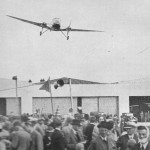 But the Douglas Pobjoy story wasn’t going to fizzle out there. Rummaging through our well loved copy of The Encyclopaedia of Sports Games and Pastimes (circa 1935) borrowed long term from Jane’s dad some years ago on account that it had I re-discovered a plate showing ‘Incidents at the start and finish of the King’s Cup Race of 1934’ and guess what was coming in low over hangars at Hatfield Aerodrome having completed the courseat 134.16 mph? Of course none other than a lovely Pobjoy powered twin-engined Monospar.
But the Douglas Pobjoy story wasn’t going to fizzle out there. Rummaging through our well loved copy of The Encyclopaedia of Sports Games and Pastimes (circa 1935) borrowed long term from Jane’s dad some years ago on account that it had I re-discovered a plate showing ‘Incidents at the start and finish of the King’s Cup Race of 1934’ and guess what was coming in low over hangars at Hatfield Aerodrome having completed the courseat 134.16 mph? Of course none other than a lovely Pobjoy powered twin-engined Monospar.
Nuremberg – Zeppelin Field Landing update
Following on from our visit to the Zeppelin Field in Nuremberg and the article that came from it, Germany Calling – What is and what should never be, it turns out that two airships visited the field or, rather, nearly did. On May 28th 1909, and only on its second flight, LZ5, with Count Zeppelin himself in command, attempted a 36 hour proving flight when it encountered heavy rain and was forced to dump all its ballast. The following evening another attempt was made and the ship finally got away from Friedrichshafen at half eleven in the evening and flew low-level throughout the night passing over Ulm and reaching Nuremberg the following morning where they had planned to descend and land on the lake, the Dutzendteich, to re-ballast however there were so many boats and sightseers that a landing was deemed impossible so the ship flew on. It then crossed Bayreuth, Hof and Leipzig. On reaching Bitterfield home of the rival Parseval Company they turned and headed back passing over Halle and Stuttgart. By now though the crew had been on station for 36 hours and extreme fatigue had set in. As a result the Count, after some questionable navigational decisions ordered the ship to be landed and in doing so collided with a solitary pear tree which collapsed the front two gas cells but fortunately no fire ensued. They’d covered over 700 miles at an average speed of 19 mph and were only about 80 miles from Friedrichschafen. Following serious lightening, the removal of four of the forward gas cells, with a crew of four and on one engine the airship made it back to Friedrichshafen where it was rebuilt. Less than a year later LZ5, then numbered ZII and under the command of Major Spercing, was forced to land out and, unmanned, broke free eventually piling up on the railway line near Weilburg.
Next contender was LZ6 on her second flight and fitted with the new lighter steel drive bands for the props rather than the conventional shafts and bevel drive and headed for Berlin with Durr in command. This flight was effectively a royal command as a result of the Kaiser being under the impression that LZ5 had been expected to visit Berlin on May 29th 1909 following its stop at Nuremberg. Three hours into the flight the front port propeller broke and a new one had to be fitted in flight, then the front engine and control wire to a ballast sack failed. It took an hour and a half before things were all running properly. So it was they managed to put down, this time as planned, on the Dutzendteich in Nuremberg on 27th August 1909 to re-ballast, refuel and replenish the hydrogen. She got airborne at around 0200 the following day and disaster followed when the front band broke again this time taking the propeller and bearing with it. Following a stop at Bittersfield LZ6 where it picked up Count Zepplin and his financier, Colsman, she finally reached Templehof Field in Berlin on the morning of the 29th. It is reported that the Kaiser entertained the Count and flight crew at the Imperial Palace in Potsdam and later that evening the ship set off on the return journey and having been flying for only a short while the other forward drive band and propeller let go, this time a blade ruptured the adjacent gas cell as it flew off. A hurried forced landing was made in a forest clearing where she remained for three days undergoing repairs which included installing shaft drive to the forward propellers. The long and short was that it was decided that proper flight trials should be completed in future. LZ6 played a big role in promoting Zeppelins airships carrying many notables on cruises up and down the Rhine. She also took part in the trials of the first experiments with radio and was fitted with the first of the hugely successful Maybach engines. LZ6 was destroyed in an ‘accidental’ hangar fire in September 1910 which netted Zeppelin 320,000 marks in an insurance payout by Lloyds of London allowing them to complete their next project LZ8 ‘Deutschland II’. Funny old world! Quite which of the two Zeppleins gave the name to ‘Zeppelin Field’ we will never know. I like to think it was LZ6. Although many Zeppelins overflew Nuremberg, including the Graf Zeppelin it is not thought any others actually landed there.
Last of the Electric locos – why the names?
We were nattering in the Swan the other night about the steam engine changes at Rickmansworth and the names of the London Transport electric locos, like you do, (‘Electric Locos – The Wendover, Barrow-in-Furness, Baker Street connection’) and their connection with the Metropolitan Railway after which they were named obviously. Well most were pretty straightforward but what happened to the nameplates. Turns out that the sign from ‘Thomas Lord’ was presented to Lords Cricket Ground. ‘Sarah Siddons’ was named after the renowned 18th century actress who played the Drury Lane and Covent Garden Theatres and whose portrayals of Lady Macbeth were so powerful that essayist William Hazlitt, described her as “tragedy personified.” She mixed with the rich, famous and the nobility and when Joshua Reynolds painted her so moved was he that he signed his name across the hem of her dress. She was born in Brecon in the former Shoulder of Mutton and now named aptly enough The Sarah Siddons Inn. She died in 1831 and was buried in St Mary’s Cemetery in Paddington. As for Number 6, ‘William Penn’, the London Transport Magazine reported that it was off to a museum in Pennsylvania. Whether that actually ever happened we don’t know.  ‘Edmund Burke’? He became Wendover’s MP back in 1765 and set up home in Beaconsfield where he is buried but in the case of ‘John Wycliffe’, we drew a blank apart from discovering he preached a lot in London and was the vicar of Ludgershall from 1368-1374 the which isn’t far from the Brill Tramway but that is stretching it a bit!
‘Edmund Burke’? He became Wendover’s MP back in 1765 and set up home in Beaconsfield where he is buried but in the case of ‘John Wycliffe’, we drew a blank apart from discovering he preached a lot in London and was the vicar of Ludgershall from 1368-1374 the which isn’t far from the Brill Tramway but that is stretching it a bit!